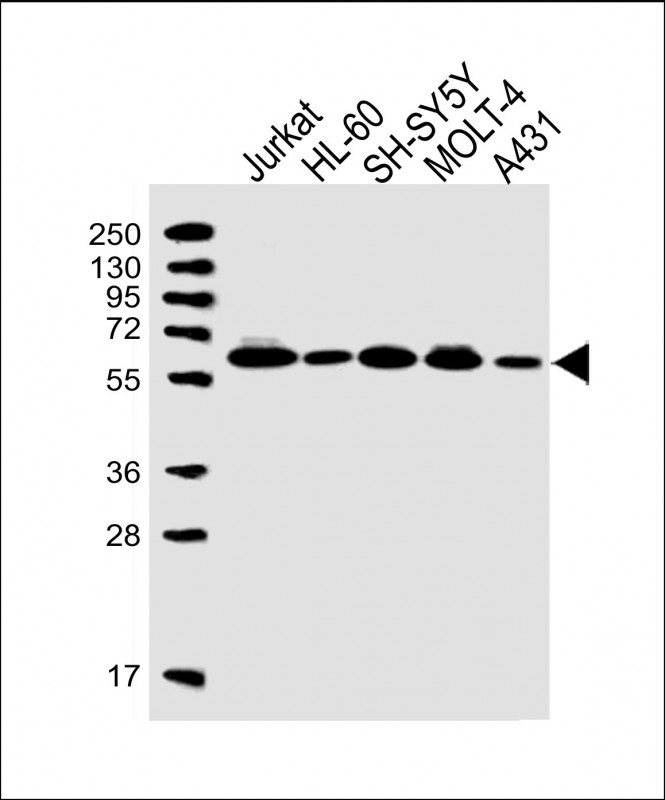DBNL Antibody (C-term)
Affinity Purified Rabbit Polyclonal Antibody (Pab)
- SPECIFICATION
- CITATIONS
- PROTOCOLS
- BACKGROUND

Application
| WB |
|---|---|
| Primary Accession | Q9UJU6 |
| Reactivity | Human |
| Host | Rabbit |
| Clonality | Polyclonal |
| Calculated MW | H=48,49,37,43,38 KDa |
| Isotype | Rabbit IgG |
| Antigen Source | HUMAN |
| Gene ID | 28988 |
|---|---|
| Antigen Region | 292-319 aa |
| Other Names | Drebrin-like protein, Cervical SH3P7, Cervical mucin-associated protein, Drebrin-F, HPK1-interacting protein of 55 kDa, HIP-55, SH3 domain-containing protein 7, DBNL, CMAP, SH3P7 |
| Dilution | WB~~1:2000 |
| Target/Specificity | This DBNL antibody is generated from rabbits immunized with a KLH conjugated synthetic peptide between 292-319 amino acids from the C-terminal region of human DBNL. |
| Storage | Maintain refrigerated at 2-8°C for up to 2 weeks. For long term storage store at -20°C in small aliquots to prevent freeze-thaw cycles. |
| Precautions | DBNL Antibody (C-term) is for research use only and not for use in diagnostic or therapeutic procedures. |
| Name | DBNL |
|---|---|
| Synonyms | CMAP, SH3P7 |
| Function | Adapter protein that binds F-actin and DNM1, and thereby plays a role in receptor-mediated endocytosis. Plays a role in the reorganization of the actin cytoskeleton, formation of cell projections, such as neurites, in neuron morphogenesis and synapse formation via its interaction with WASL and COBL. Does not bind G-actin and promote actin polymerization by itself. Required for the formation of organized podosome rosettes (By similarity). May act as a common effector of antigen receptor-signaling pathways in leukocytes. Acts as a key component of the immunological synapse that regulates T-cell activation by bridging TCRs and the actin cytoskeleton to gene activation and endocytic processes. |
| Cellular Location | Cytoplasm, cytoskeleton {ECO:0000250|UniProtKB:Q62418}. Cell projection, lamellipodium {ECO:0000250|UniProtKB:Q62418}. Cell projection, ruffle {ECO:0000250|UniProtKB:Q62418}. Cytoplasm, cell cortex {ECO:0000250|UniProtKB:Q62418}. Cytoplasm, cytosol {ECO:0000250|UniProtKB:Q9JHL4}. Synapse {ECO:0000250|UniProtKB:Q62418} Perikaryon {ECO:0000250|UniProtKB:Q62418}. Cell projection, neuron projection {ECO:0000250|UniProtKB:Q62418}. Cell membrane; Peripheral membrane protein {ECO:0000250|UniProtKB:Q62418}; Cytoplasmic side {ECO:0000250|UniProtKB:Q62418}. Cytoplasmic vesicle, clathrin-coated vesicle membrane {ECO:0000250|UniProtKB:Q62418}; Peripheral membrane protein {ECO:0000250|UniProtKB:Q62418}; Cytoplasmic side {ECO:0000250|UniProtKB:Q62418}. Golgi apparatus membrane {ECO:0000250|UniProtKB:Q62418}; Peripheral membrane protein {ECO:0000250|UniProtKB:Q62418}; Cytoplasmic side {ECO:0000250|UniProtKB:Q62418}. Cell projection, podosome {ECO:0000250|UniProtKB:Q62418}. Early endosome. Cell projection, dendrite {ECO:0000250|UniProtKB:Q9JHL4}. Postsynaptic density {ECO:0000250|UniProtKB:Q9JHL4}. Note=Associates with lamellipodial actin and membrane ruffles. Colocalizes with actin and cortactin at podosome dots and podosome rosettes. {ECO:0000250|UniProtKB:Q62418, ECO:0000250|UniProtKB:Q9JHL4} |

Thousands of laboratories across the world have published research that depended on the performance of antibodies from Abcepta to advance their research. Check out links to articles that cite our products in major peer-reviewed journals, organized by research category.
info@abcepta.com, and receive a free "I Love Antibodies" mug.
Provided below are standard protocols that you may find useful for product applications.
Background
Actin-binding adapter protein. May act as a common effector of antigen receptor-signaling pathways in leukocytes. Its association with dynamin suggests that it may also connect the actin cytoskeleton to endocytic function. Acts as a key component of the immunological synapse that regulates T-cell activation by bridging TCRs and the actin cytoskeleton to gene activation and endocytic processes. Binds to F-actin but is not involved in actin polymerization, capping or bundling. Does not bind G-actin.
References
Venkatesan, K., et al. Nat. Methods 6(1):83-90(2009)
Haeckel, A., et al. J. Neurosci. 28(40):10031-10044(2008)
Le Bras, S., et al. FEBS Lett. 581(5):967-974(2007)
Lamesch, P., et al. Genomics 89(3):307-315(2007)
Ewing, R.M., et al. Mol. Syst. Biol. 3, 89 (2007) :
If you have used an Abcepta product and would like to share how it has performed, please click on the "Submit Review" button and provide the requested information. Our staff will examine and post your review and contact you if needed.
If you have any additional inquiries please email technical services at tech@abcepta.com.













 Foundational characteristics of cancer include proliferation, angiogenesis, migration, evasion of apoptosis, and cellular immortality. Find key markers for these cellular processes and antibodies to detect them.
Foundational characteristics of cancer include proliferation, angiogenesis, migration, evasion of apoptosis, and cellular immortality. Find key markers for these cellular processes and antibodies to detect them. The SUMOplot™ Analysis Program predicts and scores sumoylation sites in your protein. SUMOylation is a post-translational modification involved in various cellular processes, such as nuclear-cytosolic transport, transcriptional regulation, apoptosis, protein stability, response to stress, and progression through the cell cycle.
The SUMOplot™ Analysis Program predicts and scores sumoylation sites in your protein. SUMOylation is a post-translational modification involved in various cellular processes, such as nuclear-cytosolic transport, transcriptional regulation, apoptosis, protein stability, response to stress, and progression through the cell cycle. The Autophagy Receptor Motif Plotter predicts and scores autophagy receptor binding sites in your protein. Identifying proteins connected to this pathway is critical to understanding the role of autophagy in physiological as well as pathological processes such as development, differentiation, neurodegenerative diseases, stress, infection, and cancer.
The Autophagy Receptor Motif Plotter predicts and scores autophagy receptor binding sites in your protein. Identifying proteins connected to this pathway is critical to understanding the role of autophagy in physiological as well as pathological processes such as development, differentiation, neurodegenerative diseases, stress, infection, and cancer.


